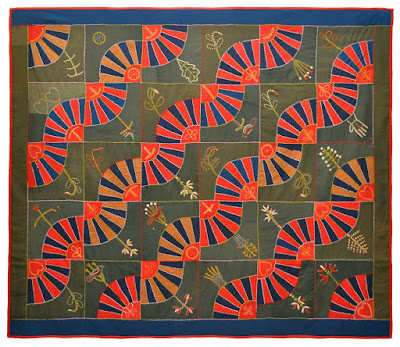 |
| 1880s pieced quilt, unknown maker, Texas |
"New York Beauty" is my favorite quilt pattern. I acquired my first one in 1989 from Shelly Zegart. It was a beautiful, 1850s red, white and green quilt with cheddar orange accents in the centers of the sunburst cornerstones.
 |
| 1850s pieced quilt, unknown maker, Kentucky |
Years later, I learned there was no way of knowing what the maker would've called the design, but people generally referred to it as New York Beauty, a 1930s name from a Mountain Mist quilt pattern.
 |
| 1930s Mountain Mist New York Beauty |
Looking at quilts for sale, there were not many made with the elaborate, pieced sunburst motif. The design was intriguing, how modern it looked even though some of the quilts were obviously very old.
 |
| 1860s pieced quilt, unknown maker, Kentucky |
If I saw a "New York Beauty" I would buy it or bid on it-- kind of an expensive hobby, collecting quilts made with one of the most complicated patchwork motifs-- but I did it for more than 25 years.
 |
| 1870s pieced quilt, unknown maker, Virginia |
Quilts in good condition were preferable, but condition did not play a big role in collecting them. It was almost like collecting mochaware. I accepted the flaws because the quilts were so hard to find.
After a while the quilts started to pile up. Maybe there were more "New York Beauties" than I first thought. People were making modern-day renditions using the design, so I started to collect those, too.
 |
| New York Beauty, 2010, by Nancy Tanguay, CT |
In 2010, the Benton County Museum invited me to show quilts. The curators wanted to display the New York Beauties because the collection presented so many variants of one motif, and that was interesting to them.
 |
| 1860s pieced quilt, unknown maker, Kentucky |
Research took time. Vetting sources of information was the biggest task. Luckily, there were approximately 40 examples in the collection by then. The quilts could tell their own stories, and it didn't need to be about what people believed.
 |
| 2011 exhibition at the Benton County Museum, Oregon |
By the time the exhibition took place in 2011, I produced an 80-page, full-color self-published catalogue, which was available with the exhibition and afterwards. The catalogue is now out of print. Subsequent publications were revised, such as the catalogue for the 2013 exhibition at the San Jose Museum of Quilts & Textiles.
Leading to that exhibition was a 2012, full-length feature article in Quilters Newsletter by Mary Kate Karr Petras. The curators in San Jose saw the article and invited me to show the quilts.
 |
| 2012 article in Quilters Newsletter |
As I was preparing for the San Jose exhibition, I got a note from New York quilt dealer Jane Lury, who had recently sold me a magnificent 1930s "Springtime in the Rockies" quilt. The quilt was made with a 1931 Capper's Weekly pattern, and it was a wonderful variant of the New York Beauty design.
 |
| 1930s "Springtime in the Rockies" quilt |
Jane told me about some friends of hers. They were from France and had a magazine, and they liked to visit homes with quilts displayed as part of the decor. They wanted to come to my house, but it was a mess. There were quilts all over the place, in preparation for the San Jose exhibition.
 |
| The French edition of the magazine, Quiltmania |
I was still learning who was who in the quilt world, and hadn't heard of the magazine before. It was Quiltmania. The next thing I knew, Carol Veillon, Guy Yoyotte-Husson and Christelle Leveque were at my house looking at quilts. They wanted to do magazine articles, an exhibition of 50 quilts in France and a coffee table book.
The book,
"New York Beauty, Quilts from the Volckening Collection" was published by Quiltmania in 2015. Shelly Zegart wrote the foreword. It was 312 pages, bilingual, and included 70 examples of the design and variants made between 1850 and 2014. It also had patterns for three quilts. The book was the culmination of 25 years of collecting, as well as many years researching the origins and history of my favorite quilt pattern.
 |
| New York Beauty bag, introduced at the 2015 Salon Pour l'Amour du Fil |
In 2015, we celebrated with an exhibit of 50 quilts at Salon Pour l'Amour du Fil in Nantes, France. It was a wonderful experience, and I made a lot of new friends from around the world.
 |
| 2015: at Salon Pour l'Amour du Fil, Nantes, France |
In 2016, the Rocky Mountain Quilt Museum and Texas Quilt Museum displayed the quilts. Since the exhibitions overlapped by a few weeks, two completely different groups of quilts were displayed. Both exhibitions reflected the history of the New York Beauty design, and the quilts were well received in both venues.
 |
| 2016 exhibition at the Rocky Mountain Quilt Museum |
 |
| 2016 exhibition at the Texas Quilt Museum |
Today, the quilts are taking a break. Many of them are in acid free storage boxes, out of the light, and not on display. I love to share the quilts, but this collection has worked hard and deserves the break.
I am considering displaying a select group of New York Beauties next summer, when I have an exhibition of quilts at Latimer Quilt & Textile Center in Tillamook, Oregon. There are other groups of quilts I am considering, but I have only showed these quilts in one exhibition in the Pacific Northwest, and that was in 2011. Of course, I will post details about that exhibition as we approach the date, and we'll see what I decide to show. If you are interested in the history of the New York Beauty patchwork design,
click here to buy the book.



























































